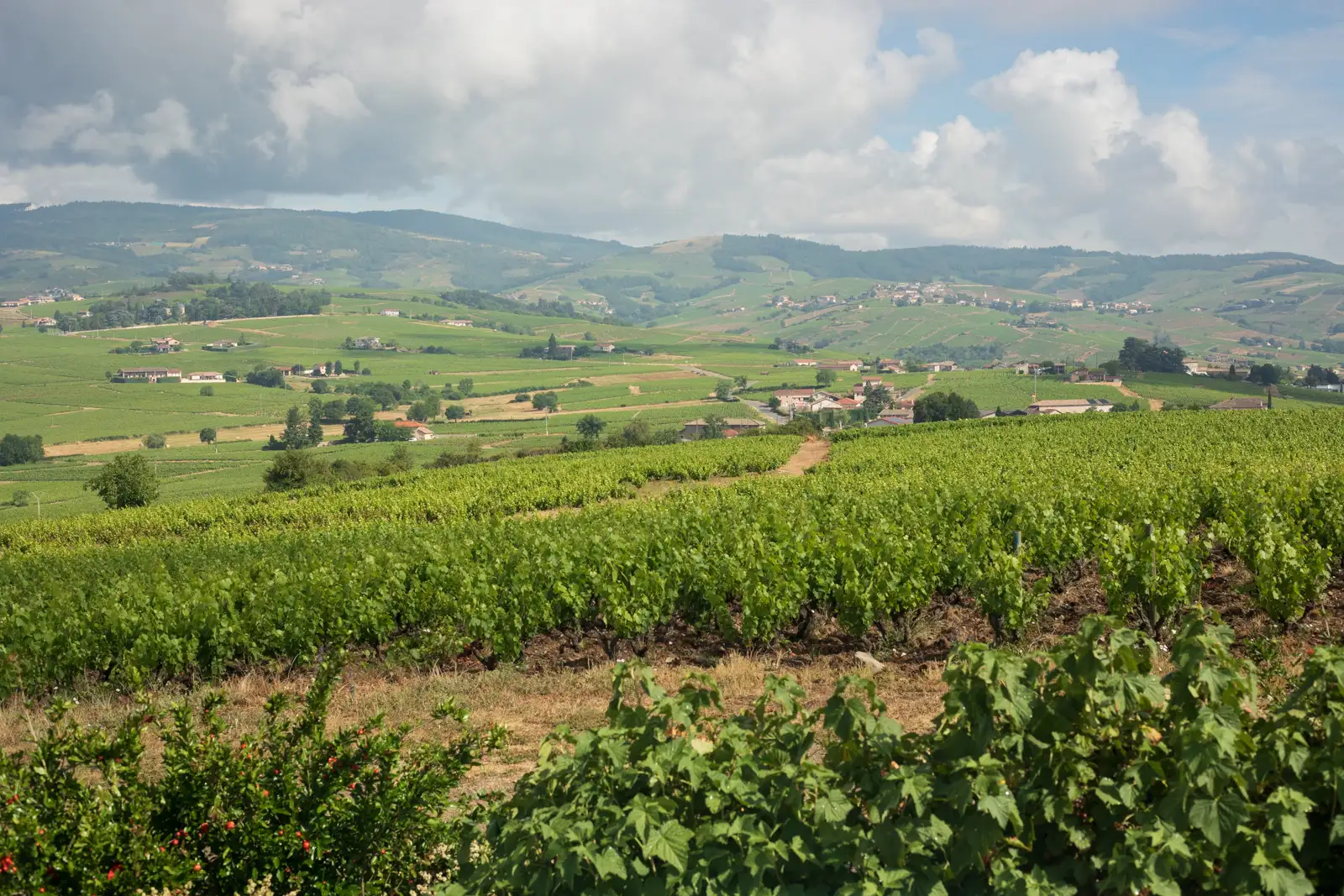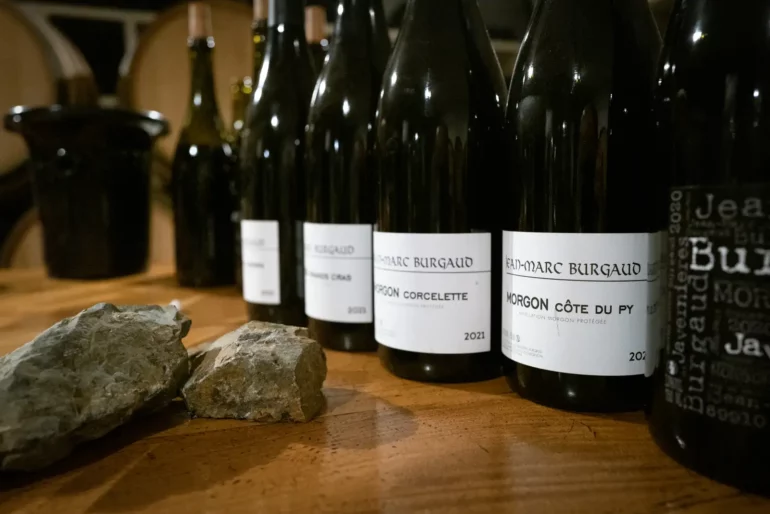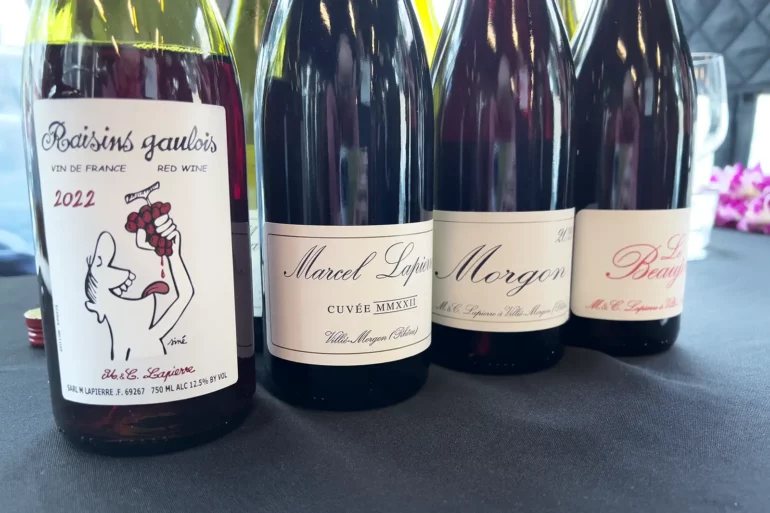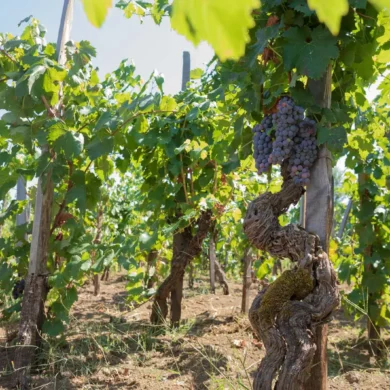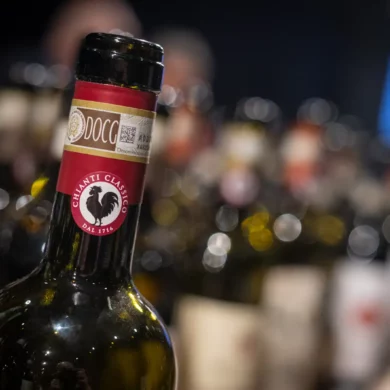Of the 10 Beaujolais Cru, Morgon is only challenged by Fleurie for having the deepest bench of winemaking talent. With a last-minute weekend to spare in the area between Abruzzo, Italy and Bourgogne, France, I was thrilled to score an appointment with one of those top talents, Jean-Marc Burgaud. Burgaud is very amiable and generous, as he spent an entire morning ushering me from lieu-dit to lieu-dit atop the Côte du Py, and pouring several of his wines for a comparison tasting in his cellar.
This was fortuitous, because to understand Morgon you have to understand the Côte du Py. And in return, as I wrote in this recent vineyard story, to understand how startlingly different the Côte du Py is, you have to understand Morgon’s other prized climat, too.
With that frame of reference, it was also interesting to spend some time earlier this month with Mathieu Lapierre of M & C Lapierre, who prefers to expound on the virtues of Morgon as a whole, with the Côte du Py as the most vital ingredient in the blend.
What follows are my notes on these winemakers’ wines. Star-ratings are merely a quick tasting impression, with five being a wine of top-level potential.
Jean-Marc Burgaud’s wines have been more available to me over the years, so that familiarity has lead to an Essential Winemakers of France page, which — as a paying subscriber — I urge you to check out below.
M & C Lapierre’s top wines sellout very quickly due to demand, but when they’re released, they not particularly hard to find in major U.S. markets, so be on the lookout. Lapierre wines are stunning and sought-after for a reason.
Jean-Marc Burgaud
“I have only one style of winemaking,” Burgaud told me in his cellar just after we had tasted his exquisite Beaujolais-Village wine from nearby Latignié. “All the grapes are whole-cluster at 23 to 26 degrees of temperature, one pumpover everyday, that’s all. And the difference between every wine is only the time in maceration.”
Because of that, it is safe to assume that variations from one wine to the next are mostly attributable to the terroir. Burgaud is excellent at shepherding those notes from the vineyard to the glass.
2022 Jean-Marc Burgaud Morgon Les Charmes
Les Charmes is a vineyard of old, broken-down granite with some trace alluvial elements thanks to its position along a watercourse. The roots have to go deep, but the soil is not nearly as nutrient-poor as the Côte du Py. Additional variables include the microclimate of the adjacent watercourse, and the way the vineyard receives morning light but is shaded late in the day.
I found this wine (★★★★★) to be beautifully decked in suggestive tones of raspberry, tea and spice, while revealing a forthcoming personality, and an almost velvety texture. How is this elegance not on a par with top Burgundy? I mused in my notes.
2022 Jean-Marc Burgaud Morgon Grands Cras
Among Morgon’s various geological profiles, the Grands Cras is almost as odd as the Côte du Py. It yields a Beaujolais Cru wine without any granite. Sure enough, looking at it from atop the Côte du Py, you can see how over a stretch of eons, gravity has brought sediment down into the vineyard. But in addition to all that clay, there is limestone as well, a key ingredient that inspires a different sort of minerality than is found from a granitic terroir.
In youth, Burgaud’s Grands Cras (★★★★ 3/4) is assertive, leathery and suggestive at times of bacon. In fact, I was reminded just as much of Northern Rhône Syrah as I was of Morgon. However, an older vintage (2021) tasted later flipped the script, anchoring our feet firmly in Beaujolais with tones recalling pomegranate and violets. This is a staggeringly beautiful wine with a lot of dynamics.
2022 Jean-Marc Burgaud Morgon Corcelette
On the surface Corcelette resembles Fleurie due to its heavy presence of pink granite. Burgaud’s lieu-dix within the vineyard is called Roche Pilée, meaning “pounded stones” because of the pebbles covering the area. Here, ample drainage of rainwater provides a different behavior in the vines, yielding a wine (★★★★ 3/4) of remarkable freshness, herbaceousness and taut minerality that lends to superior persistence. Of the four wines poured, this one had the most appealing, could-not-turn-away-from aromas.
2022 Jean-Marc Burgaud Morgon Côte du Py
From the Côte du Py Vineyard Story, I wrote:
“The transition was extreme — like walking from a tea room to a smokehouse. The Côte du Py’s (★★★★★) savory aromatics are its signature and the density of the wine feels more substantial too, but that doesn’t sufficiently describe the Côte du Py’s personality.
As the wine opened and evolved, it showed an unpredictable side that is the hallmark of many Côte du Py wines. It might sprint across the palate, or skip joyfully. It might sing an operatic soprano note or shred a guitar solo. It just depends on when you catch it in its evolution.”
2021 Jean-Marc Burgaud “Javernieres” Morgon Côte du Py
The lone two exceptions to Jean-Marc Burgaud’s winemaking formula can be found in two special cuvée from small parcels atop the Côte du Py. With Javernieres and James, he ages the wine for 12 months in moderately used oak barrels after a whole-cluster fermentation in concrete.
The “Javernieres” Côte du Py (★★★★ 3/4), the sensation was quite different. Less edgy, more rounded, more relaxed and spacious — all of it, a product of that one year of oak-aging. Tones were strongly suggestive of strawberries, blueberries, blue flowers and baking spice, and as the wine passed across the palate it felt faintly more citric in its acidity than the Côte du Py cuvée. The long finish is persistent. This is a Gamay wine for Pinot Noir obsessives.
2021 Jean-Marc Burgaud “James” Morgon Côte du Py
The “James” Côte du Py (★★★★★) comes from the parcel right by the cross commemorating the 1906 vintage. The parcel sees more sunlight and has less of a slope. Again, the tones were strongly suggestive of strawberries and blueberries, with piercing floral aromatics and superb spice. The wine seemed a little bit more rich than “Javernieres,” however, the interplay of acidity and tannin felt even more intricate — as though you could savor this wine over a week if you really wanted to.
This wine and the Morgon Les Charmes were my two favorite wines from the tasting.
M & C Lapierre
As one of the “Gang of Four ” — a band of Morgon producers who were key to reclaiming Beaujolais’ vigneron identity in the midst of the nouveau-fueled craze of the 1980s — Marcel Lapierre is a figurehead on the Mount Rushmore of natural wine. Lapierre and his “gang” not only changed Beaujolais, they sparked the natural-wine movement across France and, eventually, the globe.
Lapierre passed away in 2010 and today his son, Mathieu, and daughter, Camille, deftly uphold his legacy. Don’t get the wrong idea about the “natural wine” label here: this is not hand’s-off winemaking for hipsters, but rather extremely meticulous, uncompromising craft in service of place. If anyone can walk the tightrope of “zero-zero,” it is this brother-sister duo.
Despite their enormous reputation, their wines are reasonably priced. Expensive for everyday wine? Yes, but considering the demand and how similar the finesse level is here compared to Pinot Noir wines from Bourgogne that are priced four times as much … yes, I’d say they’re reasonably priced. The same can be said for Burgaud, but the demand for his wines is not nearly as frenzied.
2021 M & C Lapierre Morgon
This is the statement wine from Lapierre: an idealized vision of their home village and how it should taste, with the Côte du Py providing the spine, most of the muscle and quite a bit of the personality, too. The Lapierre Morgon (★★★★★) has the most incredibly pure nose, adding an unfamiliar juniper berry note to the usual mix of Gamay’s charming aromas, which seemed to carry through the wine like a sturdy sprig of resinous herbs. It certainly did not taste of the Côte du Py entirely, but there were shades of that great hill in the wine: a savory streak that — like an amplifier giving a guitar the growl it needs — reverberated across the palate.
While tasting the 2021 Morgon, I was struck by how much balanced complexity they were able to achieve — the microcosm of all the Crus that is Morgon, in a single glass.
2021 M & C Lapierre “Cuvée Marcel Lapierre” Morgon
A combination of 100-year-old Côte du Py and Le Douby climat fruit, the 2022 “Cuvée Marcel Lapierre” Morgon (★★★★★) is often seen as one of Beaujolais’ grandest wines. It too carried a similar gravitas at first — intense fruit, those resinous herbs, a hearty meatiness, and assertive tannins — yet even here, the juiciness of the finish anchored the wine in Beaujolais. “Monumental” would not be an understatement.
